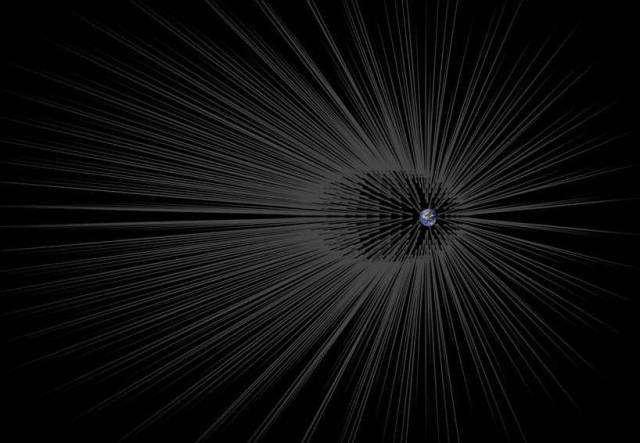Scientists proposed that Earth might be surrounded by long filaments of dark matter, or “hairs.”
A new study publishing this week in the Astrophysical Journal by Gary Prézeau of NASA’s Jet Propulsion Laboratory, Pasadena, California, proposes the existence of long filaments of dark matter, or “hairs.”
The above illustration shows Earth surrounded by theoretical filaments of dark matter. Credits: NASA/JPL-Caltech
Dark matter is an invisible, mysterious substance that makes up about 27 percent of all matter and energy in the universe. The regular matter, which makes up everything we can see around us, is only 5 percent of the universe. The rest is dark energy, a strange phenomenon associated with the acceleration of our expanding universe.
Neither dark matter nor dark energy has ever been directly detected, although many experiments are trying to unlock the mysteries of dark matter, whether from deep underground or in space.
Based on many observations of its gravitational pull in action, scientists are certain that dark matter exists, and have measured how much of it there is in the universe to an accuracy of better than one percent. The leading theory is that dark matter is “cold,” meaning it doesn’t move around much, and it is “dark” insofar as it doesn’t produce or interact with light.
Prézeau said:
“A stream can be much larger than the solar system itself, and there are many different streams crisscrossing our galactic neighborhood.
When gravity interacts with the cold dark matter gas during galaxy formation, all particles within a stream continue traveling at the same velocity”
Galaxies, which contain stars made of ordinary matter, form because of fluctuations in the density of dark matter. Gravity acts as the glue that holds both the ordinary and dark matter together in galaxies.
According to calculations done in the 1990s and simulations performed in the last decade, dark matter forms “fine-grained streams” of particles that move at the same velocity and orbit galaxies such as ours.
source NASA






Leave A Comment